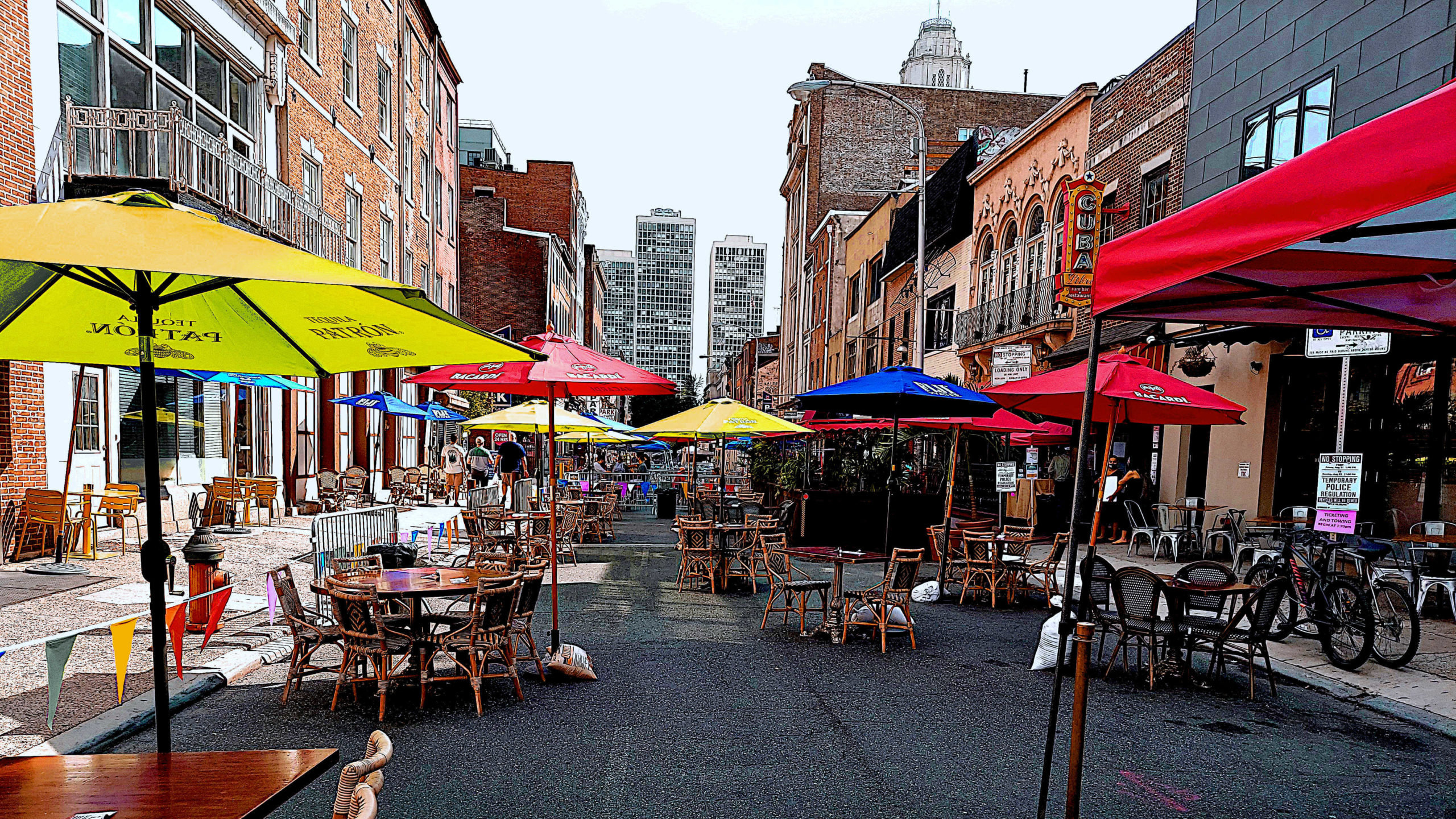If you operate a restaurant in Philadelphia, you probably know what today is: Streetery Judgment Day in Philly. Starting January 9th, 2023, all the outdoor dining patios, tents, huts, and yurts that flowered in the pandemic must be licensed or weeded from the fabled streets of Philadelphia. While Licenses and Inspections had given restaurants a pretty long leash starting in 2020, they’ve teamed with the Streets Department to yank that chain tight, ruling certain zones illegal for street dining and instituting a fee and permit structure for continued outdoor restaurant extensions. Naturally, restaurateurs (and diners!) are confused about the new Philadelphia outdoor dining rules. But never fear! Permit Philly is here to break down these new curbside seating regulations.
Streeteries vs. Sidewalk Cafés
First, let’s get this part straight: once all hell broke loose in 2020, Philadelphia was kind of letting restaurants set up seating on the sidewalk or street in front of their business as long as nobody blocked a fire hydrant or highway exit. The goal was to keep restaurants open, not sweat the small stuff.
However, back before March 2020, there was a rule on the books that allowed the Streets Department to approve sidewalk dining in certain places, after which L&I would issue a license for some outdoor tables in the walkway.
Now, Philadelphia’s outdoor dining rules update that old license for sidewalk dining, and create a new license for dining in the street. Some chairs on a sidewalk in front of Hip City Veg is a sidewalk café, according to Philly. A little patio in the Sampan parking lane is a streetery, the term L&I has been using since 2020 for any chunk of wood restauranteurs threw into the street to house diners.
If you want some sidewalk seating, you need a Sidewalk Café License, which we’re not going to cover here in detail here. If you want to keep your painted dining hut in the street, you need a Streetery License. Since Streetery Licenses have only existed in their current form since October, and are only enforced as of this writing, we’re going to focus on those.
Philly Streetery Rules: A Timeline
Back in December 2021, as Philadelphians were starting to get into the whole street-dining thing, City Council passed a measure to permanently legalize outdoor dining on streets and sidewalks. The bill had its conditions, but these seemed to be generally acceptable to the restaurant industry. And we the public could all keep eating great food outside! Some parking gripes aside, the move seemed broadly popular. Many restaurant owners even credited streeteries with saving their businesses in the depths of the pandemic, and cheered the law.
That spring, however, L&I and Streets unveiled their rules to actually implement the law. And restauranteurs were incredulous: the rules called for a $2,200 annual licensing fee (in addition to regular food license fees), a $60,000 security bond, and underground wiring or generators to keep extension cords off the sidewalk. Streeteries were even meant to be removed from the street whenever the weather turned nasty. Naturally, the outcry was intense.
So the rules were scrapped… kind of. After scaling back some of the most hated provisions of the regime, the City finally announced the Permanent Outdoor Dining Program on October 19, 2022 with the stated goal of improving safety and accessibility for all users. There’s still a pretty big license fee ($1,750), and there’s an insurance requirement as well. Instead of making restaurants pull tents and canopies inside, the City simply made those illegal: no tents in the street anymore.
Since then… not every restaurant in the city got the memo: there are far more restaurants that have done nothing or simply torn down their outdoor dining structures than restaurants that acquired the new license. As of January 9th, that probably means a lot of Philly restaurants are technically in violation of the new rules. So here they are in some detail.
And we mean some detail: the rules for each restaurant will vary. So if you’re not sure you want to put in the time and money to legalize a streetery, feel free to get in touch with Permit Philly for general guidance or a permitting report!
Minimum Outdoor Dining Requirements
According to Philly’s sparkling new outdoor dining rules, all restaurants that wish to operate a streetery – which, again, is any outdoor dining space on a street – need to start with some basic facilities. They also need to keep their licenses current. Almost any brick-and-mortar restaurant with seating will jump these first hurdles. These businesses must have…
- A current food license
- Available indoor seating and at least three tables for it
- Restrooms available to customers
- Permission from the property owner to set up outdoor dining areas (unless the restaurant actually owns the property too)
Are you ankles clear? Stretch your legs: there are some taller hurdles ahead.
Acceptable Areas for Streeteries in Philadelphia
Restaurants that are allowed to set up outdoor dining might still be limited by their location. First, only most commercial areas are allowed to feature outdoor dining at all, so the rules eliminate restaurants in most buildings zoned for residential use. (Permit Philly is happy to check this for you – we can look up your address and let you know if it can legally provide sidewalk seating).
Second, a streetery must be located in a parking lane directly in front of business and the cars still have to have 12 feet to get by. You can’t put a streetery in a bike lane, in a crosswalk, or in a narrow street. Not even in a kinda wide street if the cars have less than 12 feet to pass after your streetery is installed.
Finally, streeteries are not permitted under any circumstance when…
- They are set up in areas at high risk of flooding (as determined by FEMA)
- They compromise deployment of emergency vehicles (no streeteries, for example, across the street from or directly next to fire stations, police precincts, or emergency medical facilities)
- They are within 15 feet of a fire hydrant, 20 feet of a crosswalk or transit stop, or 30 feet of a traffic signal
Wait, what if my restaurant doesn’t have this sort of open area?
If you don’t have a space that meets these requirements, then you need City Council to actually pass a law allowing your outdoor dining area. Those are the actual rules.
This can happen! Council does pass ordinances allowing sidewalk seating in zones that don’t allow sidewalk seating by rule. The same thing will now happen with street dining patios and platforms. But Council won’t bail out restaurants whose streeteries cover fire hydrants or bike lanes – your only chance of getting this kind of relief is if your streetery simply isn’t in a commercial area, or maybe if the street is just a hair thinner than 12 feet wide.
Streetery Construction Rules
Okay, Philly has just a few more outdoor dining regs to throw at you: once you have that legal streetery zone, you have to actually build (or repair, or replace) the thing itself. For that… you might need a building permit.
Yeah, a building permit:
If your streetery is gonna have a roof – or, more specifically, if it even has walls taller than four feet – you need a building permit from L&I in addition to the Streetery License they created for you. And even better: the Art Commission gets to review your design to make sure it’s pretty enough to be worthy of fine dining! (If you want to avoid this, don’t put a roof on it, and have people site on the street itself or on a platform flush with the curb.)
Building permit or not, there are a lot of ways to design a patio or structure for curbside food service. Here are the designs and features that absolutely aren’t allowed, under any circumstance:
- You Can’t Use Propane or Open Flames
- That part is pretty simple: the city doesn’t want anyone catching on fire. But it’s really strict about this, banning duct heating from a gas furnace, fire pits, and overhead dome heaters. You’re looking at spring and summer dining unless you can figure out an electrical heater. Speaking of…
- You Can’t Lay Extension Cords Everywhere
- Yep, no extension cords or underground conduits. If you want power in your streetside shed, you need some kind of portable, non-flammable energy source, like in an Avengers movie
- You Can’t Bolt Anything to the Street
- No pavement anchors
- You Can’t Use Shipping Containers
- Look, I personally think these are cool and this hurts me to type: shipping containers are only for shipping in Philadelphia. Not for amazing, fun dining spaces.
- You Can’t
Make it Look GoodConnect Lights to the Building- No streetlights running between the streetery and the restaurant storefront. If you try to make your stretch of sidewalk visually appealing, the City of Philadelphia will end you.
- (Okay, for legal reasons we should probably be clear that last part is not how this is written in the law itself. We’re just laughing through the tears over at Permit Philly. Jokes!)
- No streetlights running between the streetery and the restaurant storefront. If you try to make your stretch of sidewalk visually appealing, the City of Philadelphia will end you.
- You Can’t Create a Streetery Dream Home
- No more sub-rooms and compartments other than dining areas! Streeteries are for eating, says the City of Philadelphia! Not for extra storage space!
Oh, and don’t forget ADA compliance!
Even if you’re in a legal zone, with proper licensure, all needed permits, and a perfectly-built deck, you still need to make certain customers with disabilities can access that deck for service. (To be clear, this is the part of the law that makes the most sense.) Minimum one (1) table that can be accessed by a wheelchair or walker, per ADA regulation.
In Conclusion
The new Philadelphia outdoor dining rules are almost as harsh on streeteries as the old rules from ten months ago. The City has made things a little easier for restauranteurs, but not much: they expect to clear a lot of streeteries off the pavement and make the survivors pretty.
There’s a lot we don’t like about these rules, and there’s certainly a lot Philly restaurant owners will hate. But if you’re game to take them on, these rules are the way to establish a permanent outdoor dining spot for your business. And if you need any help with the process, please give us a shout! We can consult on the process or take on the entire project from first application to final permit.

